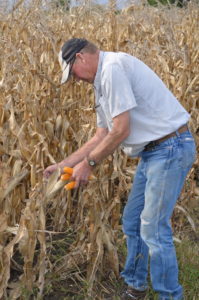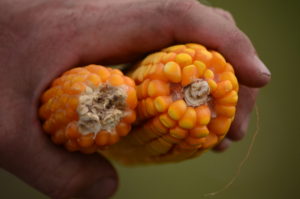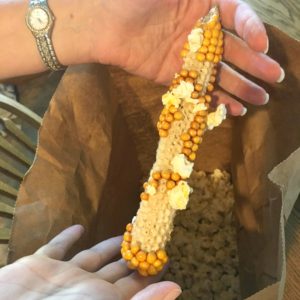From the Farm
Crop Spotlight – Kansas-Grown Popcorn
Blog written by Leah Clawson, photos courtesy of Kim Baldwin

Dwight Baldwin checking the progress of his popcorn crop to see if it’s ready to be harvested.
Pop, pop, pop – is the sound Dwight Baldwin’s newest crop makes. This year, Dwight, of Baldwin Farms, decided to try growing popcorn, and it has been an adventurous endeavor for his family.
Dwight remembers making kettle corn with his family and wondering why popcorn was not widely grown in Kansas (the majority of corn grown in Kansas is field corn, which is used in livestock and poultry feed, or other products we use, but not for human consumption). Around the same time, he also read an article in Successful Farming about alternative crops, and again popcorn caught his attention. Both of these instances led Dwight to realize he could grow popcorn as an interesting way to diversify his crops.
“The idea of growing popcorn stood out to me, and I began thinking about how I could diversify my crops by implementing a new crop. Commodity prices are low right now, making it a great time to try something new and exciting.”

Popcorn (left) and field corn (right) look different in the field. Can you see the difference?
Dwight began researching what it would take to grow popcorn on his farm in Central Kansas. He reached out to a popcorn breeder to learn about the different varieties of popcorn. Dwight also connected with Stacy Mayo-Martinez, Kansas Corn’s Director of Industry Relations, at Kansas Corn’s Central Corn Management School. Stacy connected Dwight with other industry partners in the state and encouraged him to move forward in creating a unique Kansas product.
After extensive research, Dwight planted his first crop of Jumbo Popcorn, which is also known as Mushroom Popcorn. Even though he has grown field corn throughout his farming career, growing popcorn was a new experience because of the vast differences in the two types of corn. Dwight explained the differences between popcorn and field corn.
“I planted the popcorn later in the spring than I planted my field corn because popcorn tends to produce better results when planted in warmer soil. The different planting times also worked well to avoid cross-pollination between the popcorn and field corn.”

The result of the Baldwin family’s experiment when they popped an ear of popcorn in a paper bag.
Through this experience, Dwight has also learned several other interesting differences, and even some similarities, between popcorn and field corn. For example, popcorn uses less nutrients than field corn, but it also has a lower yield than field corn. Additionally, popcorn has a higher sensitivity during harvest than field corn because it is critical to avoid damaging the popcorn kernels in order for them to actually pop.
Similar to field corn, moisture during the growing season is important for producing a quality product. However, moisture is particularly important for popcorn and its ability to pop. If the moisture in the kernels is too high or too low, the kernels will not pop correctly, as it is the moisture inside the kernels that makes them pop when heated up.
While being in the popcorn market is still new for Dwight’s family, they have already created wonderful family memories through this experience. One of their favorite moments so far was their experiment with popping an ear of popcorn in a paper bag, which they placed in the microwave. To their surprise, the experiment worked even though the kernels were still on the ear of corn, resulting in delicious popcorn.
Dwight has enjoyed growing popcorn and is excited for others to experience the popcorn he and his family have grown. If you are interested in trying this local, tasty treat, you can purchase Papa Baldy’s popcorn kernels in several stores in Central Kansas, or you can even buy in bulk. Follow Papa Baldy’s on Facebook and Instagram to find a store near you where Papa Baldy’s popcorn is sold. Be sure to savor each bite of this delicious Kansas corn.
